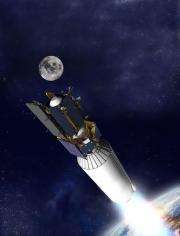New NASA Missions to Reach Moon Tuesday, Sending Back Live Video

(PhysOrg.com) -- Two NASA spacecraft will reach major mission milestones early Tuesday morning as they approach the moon -- one will send back live streaming imagery via the Internet as it swings by the moon, the other will insert itself into lunar orbit to begin mapping the moon's surface.
After a four and a half day journey to the moon, NASA's Lunar Reconnaissance Orbiter, or LRO, will be captured by the moon's gravity and prepare for the commissioning phase of its mission on June 23. NASA TV live coverage of LRO's orbit insertion begins at 5:30 a.m. EDT Tuesday, with the actual engine burn to begin orbit insertion starting at 5:47 a.m.
In addition to animation and footage of LRO, live interviews will be broadcast from NASA's Goddard Space Flight Center in Greenbelt, Md., with Cathy Peddie, LRO deputy project manager at Goddard; Jim Garvin, Goddard chief scientist; Laurie Leshin, Goddard deputy director for Science and Technology; Mike Wargo, NASA's chief lunar scientist in the Exploration Systems Mission Directorate at NASA Headquarters in Washington; Rich Vondrak, LRO project scientist at Goddard; and Craig Tooley, LRO project manager at Goddard.
At 8:20 a.m. Tuesday, the Science Operations Center at NASA's Ames Research Center in Moffett Field, Calif., will stream live telemetry-based spacecraft animation and the visible camera images from the Lunar Crater Observation and Sensing Satellite, or LCROSS, spacecraft as it swings by the moon before entering into a looping polar Earth orbit. Live video streaming via the Internet will last approximately one hour.
The live video streams of the LCROSS swingby will be available at: www.nasa.gov/mission_pages/LCROSS/lunarswingby
The LCROSS swingby starts near the lunar south pole and continues north along the far side of the moon. The maneuver will put the LCROSS spacecraft and its spent second stage Centaur rocket in the correct flight path for the October impact near the lunar south pole. The swingby also will give the mission operations team the opportunity to practice the small trajectory correction maneuvers needed to target the permanently shadowed crater that will be selected by the LCROSS science team.
During the swingby, the science team will make measurements of the moon's surface and the lunar horizon to calibrate the spacecraft's cameras and spectrometers. The LCROSS visible spectrometer will make the first near-ultraviolet survey of the selected locations on the far-side of the moon giving scientists a unique look at the concentration of minerals and elements in the lunar soil.
LCROSS and its attached Centaur upper stage rocket separately will collide with the moon the morning of Oct. 9, 2009, creating a pair of debris plumes that will be analyzed for the presence of water ice or water vapor, hydrocarbons and hydrated materials.
Provided by JPL/NASA (news : web)



















